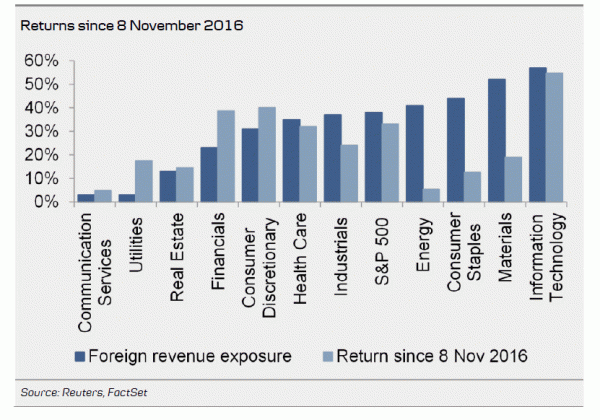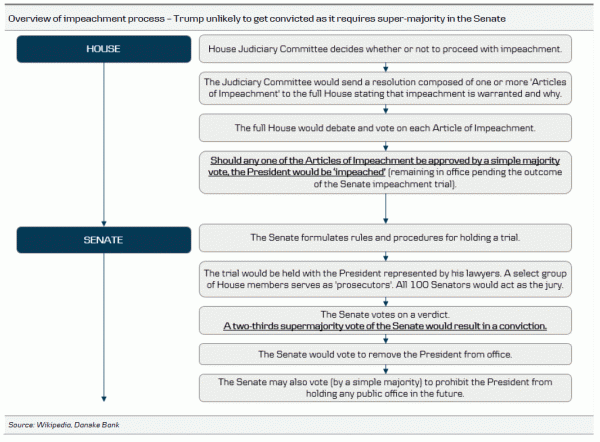Key takeaways
- With a divided Congress, we should not expect changes to economic policy and hence we maintain our view that the implications for the economy and markets should be limited. US expansion is set to continue.
- Trump has criticised the Fed but it is likely to continue its hiking cycle by hiking once more this year and three times next year.
- Democrats likely to start impeachment process but Trump is unlikely to be convicted.
- We expect Trump to remain hawkish on foreign policy. Positive signs in US-China trade war lately with a 60% probability of a ceasefire.
- The result is not a game changer for G10 FX markets. We still look for EUR/USD to move below 1.13 before year-end.
- Limited impact on US fixed income markets. We still expect 10Y UST to move towards 3.5% in 3M-6M.
- In our view, macro and monetary policy are more important for equities than politics. We are still positive on US equities.
Trump unable to get domestic agenda through Congress
The US mid-term elections are now over and the result was more or less as expected with a divided Congress. The Democrats controlling the House of Representatives and the Republicans retaining control of the Senate. This makes President Donald Trump a ‘lame duck’ in the sense that he cannot get his domestic agenda through Congress. In addition, the two parties are not very good at making politics together. We maintain our view that the mid-term elections should only have limited implications for the economy and markets, as there will be no changes to economic policy in either direction over the coming two years and while volatility has risen, this is what matters for markets. We believe the US expansion is set to continue in coming years, as optimism remains high and fiscal policy remains expansionary. Private consumption will remain the main growth driver.
Despite Trump’s criticism of the Federal Reserve’s rate hikes, we believe the Fed is going to stick to its current strategy . The Fed seems very keen on getting the Fed funds rate to 3%, which will probably happen in June next year after hikes in December, March and June. After that, it is more stop and go depending on how the economy and markets are doing but we believe the Fed will hike once more next year (i.e. four hikes from now until year-end 2019). This is in line with Fed’s own signal.
From an economic perspective, one could be worried about what is going to happen in 2020 when monetary policy has tightened further and fiscal policy is no longer expansionary.
Democrats to start impeachment process but Trump unlikely to be convicted
While the Democrats are not able to roll back Trumponomics, they will most likely start an impeachment process against Trump. While this would create a lot of headlines and noise, we do not think he will be convicted, as this requires super-majority in the Senate and the Republicans are reluctant to convict one of their own (it would probably also upset Trump’s voter base). This may change if we get a smoking gun in the Mueller investigation but we are not there yet. For an overview of the process, see chart on page 4.
Trump ready for a ceasefire with China?
As he is a ‘lame duck’ on domestic policy, Trump will most likely focus on foreign and trade policy, where he has more power without Congressional approval. US foreign policy is set to remain more hawkish than during Obama and Trump may continue to put pressure on trading partners ahead of the US presidential election in 2020. Remember, the Republicans are no longer a pro free-trade party, as 73% of the Republican voters think more protectionism is good for the US economy.
Last week, Trump signalled he might be ready for a trade war ceasefire at the Xi- Trump meeting on 1 December. According to US sources, Trump has instructed his trade officials to start drafting potential terms for an agreement. While markets welcomed the news, as it may reduce the probability of a prolonged and worsening trade war, the question is whether this was just rhetoric to improve markets ahead of the mid-term elections. We see a 60% probability of a ceasefire but any real deal will take time to reach and is unlikely to be done until some point in 2019. A 60% probability of a deal also means there is a 40% probability that the whole thing gets worse, which is quite high. In this regard, it is important to note that the Trump administration has shifted to a harsher stance against China, so it is no longer just about trade. For more, see US-China Trade: 60% chance of ceasefire at Xi-Trump meeting, 2 November.
FX: ‘Lame duck’ Trump adds marginally to list of USD positives
USD a tad weaker on as midterm result became known (with tail risk of Republican full control of Congress priced out), but as we discussed in FX Strategy – EUR/USD break of 1.13? Yes – and here’s why, 6 November 2018, the widely expected mid-term result is unlikely to be a game changer for G10 FX markets: the USD is set to enjoy continued support from US cyclical and carry outperformance. A ‘lame duck’ Trump only adds marginally to the list of USD positives: new fiscal initiatives should be minimal (i.e. no tax reform 2.0) and the trade dispute should stay confined to China (i.e. not spreading). We expect a US-China trade deal further out, but this is not imminent, and hence any relief for EUR/USD from this should not be expected until well into 2019. Hence, we still look for EUR/USD to move below 1.13 before year-end.
Emerging markets have reacted neutrally to the widely expected US midterm election result. The EM universe has followed USD’s mute reaction, while we have seen a rise in the RUB’s volatility ahead of the election. The post-election rhetoric in the US will be important for sentiment in Russia’s markets and the RUB. Anti-Russia rhetoric may return to the headlines on the meddling theme and the anti-Russia sanctions bill could see progress in the Congress soon, weighing on the RUB and local debt
FI: Initially lower yields, but it will be a temporary reaction
The election results should only have a modest impact on the US fixed income markets. It will be difficult for Trump to introduce new fiscal initiates but on the other hand, he can veto any attempts from the Democrats to roll back his laws/politics from the first two years. Hence, we are still faced with a significant budget deficit in 2019 and a record-high funding requirement. That said, the knee-jerk reaction to the result might be a modest support to US treasuries and slightly lower yields, as the risk of an even bigger budget deficit and subsequent tighter monetary policy should abate somewhat. However, any support is expected to be short-lived and we still expect a new leg higher in 10Y US treasury yields over the next three to six months. For more, see FI research: Next stop is 3.50% for 10Y US treasury yields, 15 October.
Limited equity impact
US equities are up 35% since the election in November 2016. The major drivers behind this are synchronised global expansion, tax reforms and increased US public spending. As none of these will change with the result of yesterday’s election, we see no reason to expect a significant market reaction.
With a ‘lame duck’ president, foreign policy and trade war could get even more attention. It would be straightforward to expect big cap and export-oriented sectors to suffer in this scenario but we disagree. Best performing sectors in the Trump president period and this year are cyclicals led by the tech sector, which generate the higher share of revenue abroad. At the same time, telecom is the worst performing sector despite it generating almost 100% of its revenue domestically.
This underlines our view that macro and monetary policy are much more important than politics. We recommend a slight overweight of equites and prefer Europe with a slightly cyclical tilt.




















